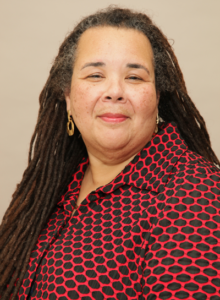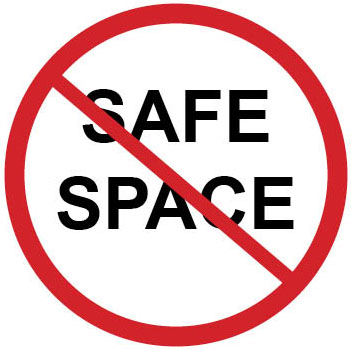
My Rant about Safe Space
Please indulge this low-grade rant. I believe the notion of “safe space” in adult classrooms is un-interrogated and oversubscribed. The question is … Safe for whom?
Well-intentioned teachers, in wanting students to attempt deep conversation, wrongly presume adult students need to feel safe in order to effectively learn. Rarely is it asked – what does it mean if the conditions which provide safety for some are the same conditions which render others vulnerable and exposed? I believe safety, as a proviso for student participation in difficult conversations, is potentially harmful for societally minoritized persons, and potentially counter-productive to the aim of critical engagement for all.
Of course, classrooms need to be spaces which are free of abuse, assault and bullying of learner and teacher, alike. Severe breeches in civility, blatant acts of hostility and covert violence are monitored by institutional policies and procedures for human rights (Title IX). The notion of safe space, as I understand it, does not attempt to guard against those encounters regulated by institutional protocols for human rights. Instead, the notion of safe space proffers itself as creating space for conversation among persons with differing interests, opinions, and worldviews. Suppose safety for the comfort of some students is made at the expense of other students?
Never have I attempted to achieve safe space in my own classrooms. Unfortunately, I have participated in conversations when “safe space” was declared by the facilitator or participant. The declaration is usually without discussion or explanation of what “safe” means in that particular ecology. In the classroom, when someone proclaims “this is safe space,” then all are expected to follow suite with this ambiguous contract of engagement. Too often, safe space is foisted upon the group without definition or consensus. This defies best practices of learner-centered classrooms.
Secondly, as I understand it, safe space is usually characterized with the inference of confidentiality.
In declaring safe space, participants are encouraged to speak openly and honestly of their thoughts and feelings because in safe space, allegedly, words will not be repeated beyond the room. Certainly, no one, given the choice, wants to feel vulnerable while doing the hard work of learning or teaching. Rather than encouraging students to build courage, hone the skills of listening, and develop a more thoughtful approach to ideas and their power, declarations of safe space lull participants into reckless disclosures of sensitive details of their lives. If then students or teachers think that what they say will not be repeated simply because of declared “safe space,” then there is a lack of awareness of human frailty and sin. After all, what happens in Vegas, NEVER stays in Vegas!  Additionally, it feels fool-hearted to suggest the therapeutic tool of confidentiality as responsibly operational in a classroom setting which does not have the expertise necessary for a therapeutic approach to dialogue. Religion and theological classrooms are never appropriate places for therapy.
Additionally, it feels fool-hearted to suggest the therapeutic tool of confidentiality as responsibly operational in a classroom setting which does not have the expertise necessary for a therapeutic approach to dialogue. Religion and theological classrooms are never appropriate places for therapy.
Thirdly, safe space seems to imply persons who risk speaking have the promise of no accountability. Persons are instructed that they can speak honestly, openly – as if the lure of safety will bolster the confidence of the shy or the weak. Problematically, safe space views conflict and behaviors of consternation as bad and to be avoided in classrooms. This politically-correct attitude unwisely implies that everyone has the right and privilege to feel safe everywhere. Built into this cavalier vagueness is the presumption that judgement is suspend-able during the discussion – meaning, words have no binding, communal consequences for the person who speaks them. Detaching the words from the person who speaks is the politic of western, supremacist thought. Disembodying the spoken words from the one who speaks feels counter-productive to embodied, liberative pedagogies.
Finally, those with privilege - inherited, granted or snatched - exercise few coping skills for feelings of vulnerability and powerlessness in adult classroom spaces. The notion of safe space is initiated when those who are un-accustomed to being vulnerable are pushed beyond their norms of experience. Safe space, then, leaves those with societal targets on our backs (women, LGBTQ, economically disenfranchised, non-white, etc.) to listen to those in power who now, in safe space, can speak with reckless abandon. The speaker, shrouded in safety, naively and insensitively escalates to sentiments which too often spring from narrowness of experience and ignorance of the ruthless politics of body and oppression. The wounding, jagged politics of gender, sexual orientation, class, and race is exacerbated in safe space. Safe space primarily serves to create comfy, hotbeds of spoken bias and arrogance which potentially demeans, brutalizes and belittles those who are expected to listen in the vacuum of safety.
This is the 9th post in this series by Nancy Lynne Westfield this semester (Fall 2015).
Dr. Westfield, I have always viewed the notion of a declared safe space in adult classrooms as one that creates ingenuous dialogues, often occupied by several well intended individuals with guarded speech to ensure political correctness. I am all for gatherings being deemed a safe space where honest respect of all human races is exhibited and the classrooms are free of bullying of learner and teacher. In general, I have found a safe space in adult classrooms can be thought provoking, enlightening and challenging if all involved are open to share and receive.
The declaration of “safe space” has never determined what I have shared. As a matter of fact, I hear it being declared and by the time the conversation begins, I have usually forgotten that it was even stated. It’s not that I don’t feel the importance of adhering to this agreed upon notion to guard the civility of others, however, it is more about me making a personal choice about what I will and will not share. I determine what to share depending on the situation or circumstance. If I believe that what I share will help someone with clarity our understanding or even teach someone, then that is usually what determines the depth of my transparency.
It’s interesting that you say, “The declaration is usually without discussion or explanation of what “safe” means in that particular ecology.” Yes, it’s true that we come with our own understandings and I even believe we come knowing which part of that meaning is most meaningful for us: Is it the “It’s okay to be open, vulnerable, deeply entrusting” part or is it the “please respect the value of others and do not disclosures the sensitive details of their lives.” part? For me, it is usually the second part that is most meaningful.
Thanks for sharing!
Dr. Westfield, This is such a gift to read your words on communication in the classroom and to what degree do we and students alike have the freedom to speak our minds. Really to speak our mind and values reveals a part of who we are. And the fact is true that revelation for one individual could feel like an intrusion to another of a different culture or perspective and so the question you ask and the concerns are real. How do we do this without sacrificing a part of our soul that becomes compromised? Is speaking a truth a serious issue or necessary as Bel Hooks invites her own students to do? I have a student who shared a truth but went too far and a week later the rest of the students were upset over what they identified as crossing boundaries. This week I spoke to the student about this and addressed the idea of boundaries and to what degree do we address issues as they relate to the syllabus and our lives. Yes, you have raised a point that is meaningful.
Thank you.
Safe space sounds like therapy support group, where you could share your story and nobody is allowed to say anything out of the room. I heard so many people around my experience they like to enjoy support groups, but you never seeing them being part of a small bible study group. Do we do the confidentiality at our churches? Or the people don’t feel they could be real in the church. I can see for how long the church space is a privileged space for saints no for real people who want to be who they are. As speaker or teacher, I’m included in the judgement position “as minister” trying to reach numbers to be Christians not interested in people who need love through my “power of empathy” (Pink, 165). My empathy could reach more people than any word and safe space because create the space with ourselves to all people.